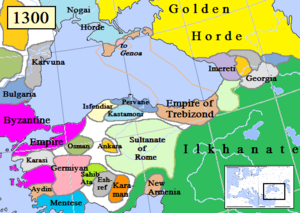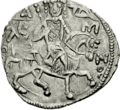Alexios II of Trebizond facts for kids
Quick facts for kids Alexios II Megas Komnenos |
|
|---|---|
| Emperor and Autocrat of all the East, of the Iberians and of Perateia | |

Coin depicting Alexios II Megas Komnenos mounted on a horse
|
|
| Emperor of Trebizond | |
| Reign | 16 August 1297 – 3 May 1330 |
| Predecessor | John II |
| Successor | Andronikos III |
| Born | 1282 |
| Died | 3 May 1330 (aged 47–48) |
| Spouse | Djiadjak Jaqeli |
| Issue | Andronikos III Megas Komnenos Basil Megas Komnenos Michael Anachoutlou George Achpougas Anna Anachoutlou Eudokia |
| Dynasty | Komnenos |
| Father | John II Megas Komnenos |
| Mother | Eudokia Palaiologina |
Alexios II Megas Komnenos (born between September and December 1282 – died May 3, 1330) was the Emperor of Trebizond. He ruled for 33 years, from 1297 until 1330. Alexios was the older son of Emperor John II and Eudokia Palaiologina.
Alexios was a very skilled and strong leader. During his time, the Empire of Trebizond became very successful and wealthy. He successfully fought off attacks from Turkish groups and managed the powerful trading cities of Genoa and Venice. He also supported artists and scientists, like the astronomer Gregory Chioniades.
Contents
Becoming Emperor
Alexios became emperor when he was just 14 years old, after his father passed away. His uncle, the Byzantine Emperor Andronikos II Palaiologos, became his guardian. His uncle wanted Alexios to marry a daughter of a high-ranking official.
However, Alexios had other plans! Around 1300, he married an Iberian princess named Djiadjak Jaqeli. She was the daughter of Beka I Jaqeli, a powerful ruler from Samtskhe. Alexios did this without asking his uncle's permission.
His uncle, Andronikos, tried to get the marriage canceled by the Church. But the Church refused because Alexios's wife was already expecting a baby. Even Alexios's mother, Eudokia, who came back to Trebizond to try and convince him to end the marriage, actually told him to stay with his Iberian wife.
Protecting the Empire
Alexios faced many challenges during his rule. One of the biggest was dealing with invaders and powerful trading rivals.
Fighting Off Invaders
In 1301 or 1302, Alexios successfully stopped an invasion by a group of Turks. These Turks had taken over a province called Chalybia and then moved deep into Trebizond's lands. They even attacked Kerasous (modern Giresun), which was the second most important city in the empire.
Alexios managed to capture their general. To protect the city, he built a strong fort overlooking the sea. This helped secure the city from future attacks.
Dealing with Pirates
Pirates from the Emirate of Sinope were another big problem. They often attacked Christian traders, including the Genoese. In 1319, these pirates even set fire to parts of Trebizond itself!
To keep his people safe, Alexios built strong sea walls around the city's harbor in 1324. He had also created a police force more than ten years earlier to guard the city at night.
Managing Trade Rivals
The Genoese were very powerful traders in the Black Sea region. They had a special agreement from 1261 that gave them a lot of control over trade. Their trading settlement near Trebizond, called Daphnous, was growing very fast. The Genoese wanted even more space and refused to let the emperor's officials check their goods.
In 1306, Alexios said no to their demands for more land. The Genoese then threatened to leave Trebizond completely. When they refused to pay taxes on the goods they were taking with them, Alexios ordered his Georgian soldiers to attack them.
Even though Alexios's troops won, the Genoese set fire to the suburbs of Trebizond, causing a lot of damage. Eventually, both sides made peace. They signed new agreements in 1314 and 1316.
However, tensions continued. So, in 1319, Alexios made a deal with the Venetians, who were Genoa's main rivals. He gave the Venetians the same trading rights as the Genoese, as long as they paid their taxes. This showed that Alexios was smart about managing these powerful foreign traders.
Later Life and Legacy
Like his father, Alexios II also received letters from the Pope, John XXII, in 1329. The Pope wanted to convert him to Catholicism.
However, Alexios became very ill and passed away on May 3, 1330. He had ruled for 33 years. After his death, his oldest son, Andronikos, became the new emperor. Two important writings about Alexios's death still exist today: a speech given at his funeral and a later tribute.
Coinage
During Alexios's reign, the coins used in Trebizond, called aspers, changed quite a bit. Their silver content was reduced by 15%. Also, the images on the coins changed. Instead of showing the Emperor and Saint Eugenios standing, they were both shown riding horses. This horse-riding image became common on coins in the Black Sea area and continued to be used on Trebizond coins until the empire fell in 1461.
Family Life
Alexios II had at least six children with his wife, Djiadjak Jaqeli. These children were:
- Andronikos III, who became Emperor of Trebizond from 1330 to 1332.
- Basil, who was Emperor of Trebizond from 1332 to 1340.
- Michael Anachoutlou, who was sadly killed by his brother Andronikos III in 1330.
- George Achpougas, who was also killed by his brother Andronikos III in 1330.
- Anna Anachoutlou, who was a nun but later became Empress of Trebizond from 1341 to 1342.
- Eudokia, who married the Emir of Sinope.
Some historians suggest he might have had another daughter who passed away in 1342.
However, some sources suggest that Alexios had three wives. One was Pekai (Djiadjak Jaqeli), who was the mother of Andronikos, Basil, and Eudokia. Another was the daughter of a ruler named Anachoutlou, who was the mother of Michael Anachoutlou and Anna Anachoutlou. The third suggested wife was named Sargale, who was the mother of George Achpougas.
Images for kids




